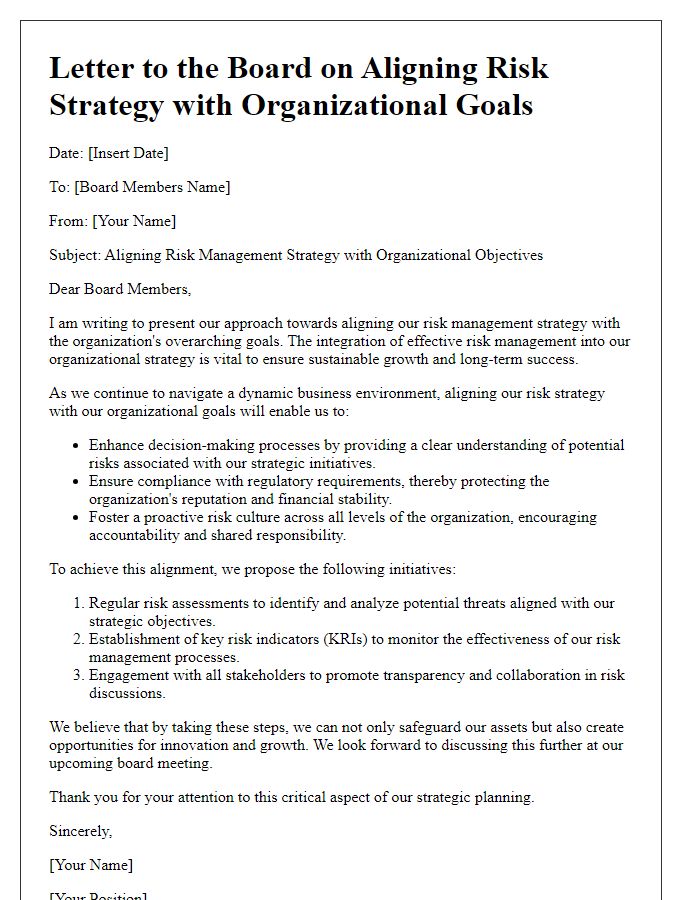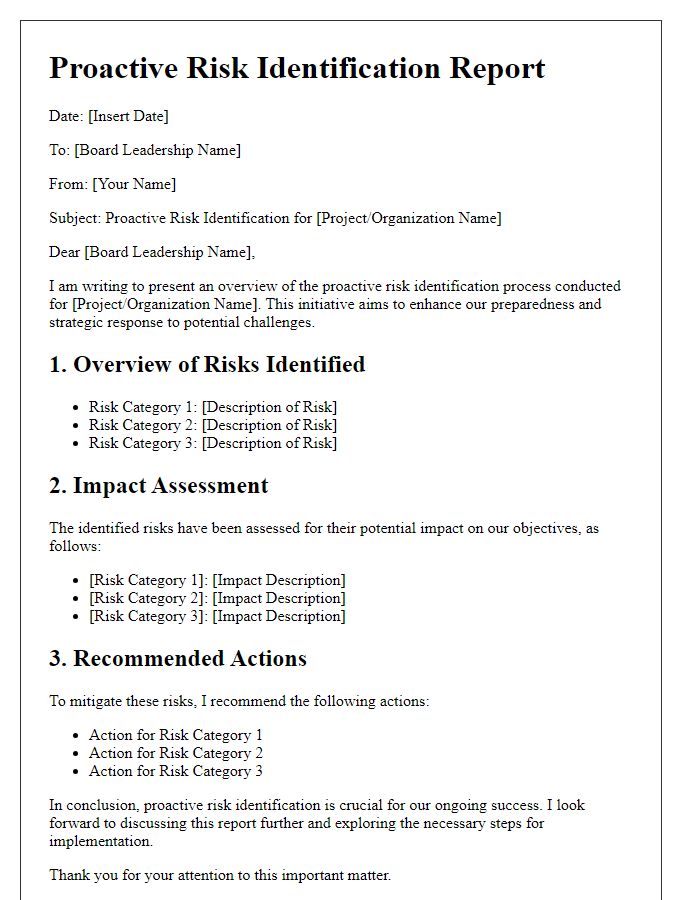Are you looking to enhance your organization's risk management strategy? Crafting a letter to the board of directors is an essential step in communicating your ideas and ensuring alignment on risk priorities. In this article, we'll guide you through a sample letter template that covers all the critical elements of an effective risk management approach. So, let's dive in and discover how to articulate your strategy in a clear and engaging way!

Clear Risk Identification and Assessment
Effective risk management involves meticulous identification and assessment of potential hazards that could impact organizational objectives. The framework for Clear Risk Identification includes systematically cataloging risks, such as operational disruptions, financial uncertainties, and compliance failures, ensuring that each risk is thoroughly described and categorized. This process is essential for identifying specific vulnerabilities within the organization, whether they arise from internal processes or external market fluctuations. Assessment of these identified risks requires qualitative and quantitative methods; metrics such as likelihood of occurrence and potential impact will dictate their prioritization. Tools like SWOT analysis (Strengths, Weaknesses, Opportunities, Threats) provide valuable insights into internal attributes while PESTLE analysis (Political, Economic, Social, Technological, Legal, Environmental) helps gauge external influences. Utilizing software solutions like risk management platforms can automate data collection, streamline the assessment process, and facilitate real-time monitoring, allowing the organization to remain adaptive in a dynamic environment. Implementing robust documentation practices will ensure transparency and accountability throughout the risk management process.
Defined Risk Appetite and Tolerance Levels
Defined Risk Appetite and Tolerance Levels serve as critical components of a board director's risk management strategy. Risk appetite (the amount of risk acceptable to achieve objectives) is essential for guiding decision-making within organizations, considering factors like market volatility and industry-specific challenges. Tolerance levels (the acceptable variation in performance relative to established objectives) provide a framework for assessing risk exposure, ensuring alignment with organizational goals, especially for publicly traded firms like Fortune 500 companies, where investor expectations are heightened. Establishing clear metrics for both constructs enables effective monitoring and enhances the organization's ability to respond to potential threats, such as regulatory changes or cybersecurity breaches. Furthermore, regular reviews of these parameters ensure they remain relevant in a rapidly evolving business landscape, fostering resilience and sustainable growth.
Comprehensive Risk Management Plan
A Comprehensive Risk Management Plan outlines essential strategies for organizations, particularly in the corporate sector, to identify, assess, and mitigate risks effectively. This plan includes key components such as risk assessment processes, risk appetite definitions, and response strategies tailored to specific industry challenges. It emphasizes the importance of an organized framework to monitor risk exposure continuously, which is crucial for maintaining operational integrity. Additionally, the inclusion of contingency plans for unforeseen events, such as natural disasters or financial crises, ensures that organizations can recover and adapt swiftly. Effective risk communication between stakeholders, including board directors and executive teams, is vital for fostering a culture of risk awareness. Regular reviews and updates to the risk management strategies ensure alignment with evolving business landscapes, regulatory requirements, and emerging threats, enhancing the organization's resilience and competitiveness in today's dynamic market.
Stakeholder Engagement and Communication
Stakeholder engagement and communication are crucial components of an effective risk management strategy in organizations, including public companies and non-profits. Organizations must identify key stakeholders such as shareholders, employees, customers, and regulatory bodies to ensure their concerns and expectations are addressed. Regular communication, through channels like quarterly reports and town hall meetings, fosters transparency and builds trust. Engaging stakeholders in risk assessment processes, such as surveys or focus groups, can provide valuable insights into potential risks, enabling a more comprehensive risk management approach. Moreover, dedicating resources to training programs for staff enhances their understanding of risk management practices, ensuring everyone is aligned on objectives and strategies. Implementing feedback mechanisms allows for dynamic communication and continuous improvement of the risk management strategy.
Continuous Monitoring and Evaluation
Continuous monitoring and evaluation in risk management involves systematically assessing potential threats to an organization's objectives, ensuring adaptability in dynamic environments. Organizations such as Fortune 500 companies implement frameworks like the COSO ERM (Committee of Sponsoring Organizations of the Treadway Commission Enterprise Risk Management) to identify risks (financial, operational, compliance) and assess their impact through quantitative metrics. Regular reviews of Key Risk Indicators (KRIs) provide insights into risk trends, enabling proactive responses before issues escalate. Tools like risk dashboards (real-time data visualization software) facilitate quick decision-making, essential for maintaining operational integrity. Stakeholder engagement, particularly in high-stakes sectors like healthcare and finance, is critical for ensuring comprehensive coverage of potential risks, making adaptation to regulations such as GDPR or HIPAA a priority in evaluation processes.
Letter Template For Board Director Risk Management Strategy Samples
Letter template of strategic oversight for board director risk management.

Letter template of stakeholder engagement in risk management for board directors.

Letter template of aligning risk strategy with organizational goals for board.

Letter template of regulatory compliance risk management for board directors.










Comments